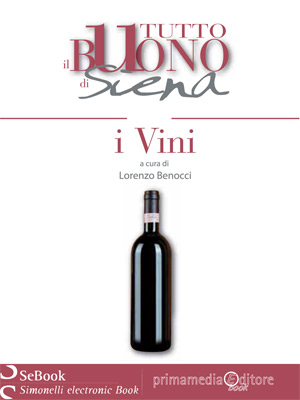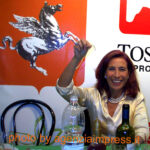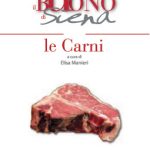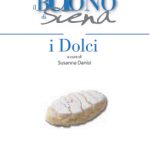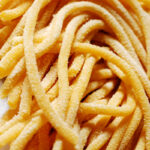Brunello di Montalcino – DOCG
Montalcino is a town in Siena’s province, famous for its great wine, the Brunello. This wine is exclusively produced by using grapes from Sangiovese’s grapevines (here named “Brunello”): the use can be made only after the sixth year following the harvest, with an obligatory finery in oak containers (for two years) and then in bottles (at least for six months). Its colour is intense ruby-red, its scent is strong and typical. Its taste is dry, tough, harmonious, strong. The minimum gradation is 12.5°, so a light settling before drinking is suggested, it can be well matched to courses having strong flavours, as for example salamis and seasoned sheep milk’s cheese, red meats and wild boar.
Classical Chianti – DOCG
Produced in the municipalities of Castellina, Gaiole and Radda in Chianti, partly Castelnuovo Berardenga and Poggibonsi, and also Greve in Chianti, Barberino Valdelsa, San Casciano and Tavarnelle Val di Pesa, this wine stands out for the Sangiovese grapes (minimum 80%), to which we can add those of other red-berry grapevines but only if suggested and/or authorized by local administration offices. In this wine’s production it’s always included an ageing of not less than twenty-four months, three of which are of finery in bottle. It’s a clear wine, its colour is vivid ruby-red tending to have grains as it ages. Its scent is strong, typical, ethereal, its taste harmonious, salty, dry, it refines as time goes by. The minimum grade must be 12°. It matches to “plentful” courses, such as the Florentine steak, tripe, “scottiglia”, “ribollita”, “al fiasco” beams and pork on the spit.
Colli Senese Chianti – DOCG
Vino Chianti is one of the foremost red wines known in Italy, and not only, it is produced in many areas of Tuscan territory. The Chianti dei Colli Senesi stands out for its Sangiovese grapevine (minimum 75%), to which we can add the Cannaiolo Nero grapes (maximum 10%), the ones of Trebbiano Toscano and Malvasia del Chianti (maximum 10%), but also the ones from red-berry grapevines suggested and/or authorized by the local production authorities (maximum 10%, 20%). This wine must be aged two years, period of which three months of finery in bottle. Its colour, vivid ruby-red can tend to be grained as the aging goes by; while its taste stands out for its being harmonious, dry, salty, and softly tannic. Its scent in strongly wine-like, sometimes with violet scent. The minimum gradation is 11.5° and well matches to so many courses: panzanella, Tuscan sheep milk’s cheese, beams, tripe, pork on the spit, Florentine steak, “al fiasco” beams, scottiglia, and so on…
Chianti “Rufina” – DOCG
Produced in different Tuscany areas, and especially in those of Siena, Florence and partly Pistoia, Arezzo and Pisa, it’s a wine obtained from grapevines not more than 550 metres high over the sea level. The grapes here are Sangiovese (75%-90%), Canbaiolo Nero (5%-10%), Trebbiano Toscano and Malvasia del Chianti (maximum 10%). Its color is vivid ruby-red, glittering, getting shades of grains as it ages. It has a strongly wine-like scent, its taste is dry, salty and harmonious, tending to be velvety and soft as time passes. Minimum gradation of 11.5°, it is aged for at least five years (compulsory). Very good to match it to white or red meats, roasted meat, game.
Vernaccia di San Gimignano – DOCG
The small town in Siena province is famous not only for its towers, but also for this extraordinary wine, one of the first to get the DOC label. Almost exclusively produced by the grapevine with the same name in Vernaccia (a possible adding of other grapevines of white-berry gets to a maximum of 10%), it’s a wine aged for at least fourteen months, four of which for the finery in bottle. Its colour is yellowish, tending to be golden as it ages. Its taste is dry and harmoniuous with a typical bitter after-taste, which melts to its intense soft scent very well. Minimum gradation of 11°. Very good when matched to fish courses, though it matches to other courses very well, such as panzanella, tomato sauce in pieces, “acquacotta”.
Nobile di Montepulciano – DOCG
Montepulciano’s noble wine is the one produced in this town, part of Siena’s province. Its grapes come from Sangiovese’s grapevines (minimum 70%), named in Montepulciano “Prugnoli Gentili”, according to the regulation standing on 700m. of height. “Canaiolo Nero” can be added (maximum 20%) and the grapevines suggested and/or authorized by the Siena province ( the percentage of white grapes can’t be higher than 10%). This wine’s aging consists in two parts: for twenty-four months it matures inside the wood, then for other eighteen months in a different container. Finally, the finery in bottle is of six months, at least. Ruby-red wine, tending to have grains as it ages. Its scent is ethereal, strong, typical and its taste is dry, balanced, persisting, possibly reminding of wood. Minimum gradation of 12.5°. Very good if matched to abundant courses: Florentine steak, stews, braised and game courses.
Orcia Rosso – DOC
A wine produced from Sangiovese grapevines (minimum 60%) and from other grapevines authorized by Regione Toscana but not aromatic. It enters the market after twenty-four months of aging. Its colour is dark ruby-red its scent is fine and complex, it recalls fruit aromas. Its taste is strong, harmonious, persistent. Its minimum gradation in 12°. To be served at a temperature of 16-18°C, it can be matched to meats, seasoned cheese and to courses on the basis of truffle, which Vald’Orcia area is very rich of. On the market the versions of Vino Bianco and Vin Santo ( but obtained from a different typology of grapevine, The Trebbiano Toscano) are also available.
Rosso di Montalcino
The Rosso di Montalcino wine comes from the same grapes as Brunello, so from Sangiovese grapevines, but it’s aged in a different way, from four to twelve months in oak barrels (or barriques) and enters the market one year after the harvest. This wine must be drunk by five years after the harvest. It has a ruby-red colour, while its scent is strong and typical. Its taste is clear, dry, hot and softly tannic. The alcohol gradation is of minimum 12°. Its features are underlined by the typical Tuscan food, with its healthy and clear taste. It matches to not too abundant main courses, such as pasta, meat sauce, chicken, mushrooms, truffles, mixed rice; then to second courses such as beef or calf. It must be served in crystal drinking cups suited for red wines, at a temperature of about 18°C.
Rosso di Montepulciano – DOC
This wine, controlled according to the Italian “Denominazione di Origine Controllata”, comes from Sangiovese grapevines (in Montepulciano they’re called “prugnoli gentili”) (minimum 70%) to which we can add Canaiolo Nero (maximum 20%) and other grapes suggested and/or authorized by the production authorities of Siena province. Besides the aromatic grapes are excluded, except Chianti’s “malvasia”. It’s a wine aged in oak barrels for two years and refined for at least two months in bottle. Its colour is typically ruby-red, its scent intensely characteristic of wine, and its taste is dry, persistent and softly tannic. The minimum gradation is 11.5°. It matches to main courses like meat sauce, white and red meats and game very well.
San Gimignano – DOC
Next to the more popular Vernaccia, in San Gimignano other wines are produced, being of ”Denominazione di Origine Controllata”. This mark Includes different types of wines: Novello, Riserva, Rosato, Vin Santo and Vin Santo called “Partridge’s Eye”. The types Rosso, Novello and Rosso Riserva are obtained by Sangiovese (minimum 50%) and other red-berry grapevines until a maximum of 50%. The type Rosato is obtained from: Sangiovese (minimum 60%), Canaiolo Nero (until a maximum of 20%), Tuscan Trebbiano, Chianti Malvasia and San Gimignano Vernaccia (until a maximum of 15%), and other red-berry grapevines for a maximum of 15%. Vin Santo is obtained from Chianti Malvasia grapes (until a maximum of 50%), Tuscan Trebbiano (minimum 30%), San Gimignano Vernaccia (maximum 20%) and other grapevines until a maximum of 10%. The “Partridge’s Eye” Vin Santo has a base of Sangiovese (from 70 to 100%), with possible addition of other red-berry grapevines. San Gimignano Rosso has a more or less strong ruby-red colour tending to be grained as it ages; a delicate wine-like scent and dry, harmonious, thick, tannic at the right point. The minimum gradation is 11.5° (12° for the Riserva). Novello has a vivid ruby-red colour with violet reflexes, a wine-like fruity scent and a salty, velvety, soft taste. Alcoholic rate of minimum 11°. The rose type distinguishes for its ruby-red reflexes, more or less intense, for its wine-like fruity delicate scent, recalling just jammed grapes. Its taste is delicate, velvety, harmonious. Alcohol rate of minimum 11°. The Vin Santo features a colour shading from golden to amber, an intense delicate ethereal scent and a lovely, dry, full, soft, persistent taste. Its minimum gradation is 16.5°. the aspects of “Partridge’s Eye” Vin Santo are those of a pale rose, an intense scent and a sweet, soft, velvety, round taste. Its minimum alcohol rate is 16°. Red wines can be matched to red meats, roasts, game, seasoned cheese very well; very good are cold-cuts matched to the rose wine; cakes and pastries to Vin Santo.
Moscatello di Montalcino
This wine of old traditions drives From white muscatel wine, with a possible addition of those coming from grapevines (maximum 10%) produced in the same municipality the popular “Brunello” comes from. Its partially dried grapes ( in fact it’s a “late harvest”), are harvested since the 1st of October and aged for until eight years. A yellowish wine, its scent is typical and delicate, its taste is fresh, persistent, aromatic. Having a minimum gradation of 10.5° it can also be produced in a sparkling version, with a fine lively scum which doesn’t change its features: in this case gradation is over 15° and wine must be refined for twelve months. To serve at the end of the meal at a temperature of about 12°C. Very good with dessert.
Chianti Vin Santo – DOC
Produced from grapevines of white Malvasia type and /or Tuscan Trebbiano (from 70% to 100%), this wine is also interesting for its production techniques. Traditionally Vin Santo was produced by harvesting the best grapes (so-called “best choices” harvest) and letting them dry for a long time, deposing them on mats, hanging them on hooks (the grapes were traditionally “put on mats” or hung in the wane of the moon, called “hard moon”, not to let them become rotten). After being dry, the grapes were jammed and the must (with or without the peel, depending on the tradition) was put into vases made of various woods and of different sizes ( generally between 15 and 20 litres) from where previously made Vin Santo had just been taken away. During this procedure they were to make sure the old dregs wouldn’t get out of the vase, since it was believed to be responsible for a good production of the Vin Santo, so much important that they called it the “mother” of Vin Santo. The vases were sealed and generally put in the villa’s attic or under the roof, because the strong differences of temperature from winter to summer would favour the fermentation and/or the wine’s scents. Generally, they thought three years of fermentation/aging would be enough to get a good Vin Santo. While in modern production we usually use brand new wood containers – or partially new- and cause fermentation by injecting selected leavens, adapt to high sugar concentrations. We tend to have the same hygienic rules as for all the other wines. Many producers, anyway, add a certain quantity of “mother” to re-create a spectrum of traditional scents. An extraordinary amber wine derives from it, having golden and yellowish shades. Its scent, intense and typical, matches to a harmonious velvety dry taste very well, or sometimes it’s rounder, as the types of Abbocato, Amabile, Dolce. Its minimum gradation is 15.5°, it matches to second courses or pastries: ideal with typical Siena’s “cantucci”.
Vin Santo of Classical Chianti – DOC
There are two typologies of this special wine: the Montepulciano Vin Santo (also Riserva) and the Montepulciano “Partridge’s Eye” Vin Santo. The former is obtained from white Malvasia, from “Grechetto”, (here called “Palcinculo”) and from Tuscan Trebbiano; other possible addition of authorized/suggested by authorities wines can’t be over 30%. The latter is obtained from Sangiovese “Prugnolo Gentile” (minimum 50%) grapes and other suggested or authorized grapevines in Siena province. The traditional way of vinification consists in harvesting grapes with accurate “cernita” and putting them to dry in airy rooms. Grapes must be juiced not before the 1st of December for the Montepulciano Vin Santo; 15th January for Vin Santo di Montepulciano di Riserva; 28th February for “Partridge’s Eye” Vin Santo di Montepulciano. The keeping and aging must be done in wooden containers of not more than 300 litres for Vin Santo di Montepulciano; in vases of not more than 125 litres for Vin Santo di Montepulciano Riserva; in vases of not more than 75 litres for the “Partridge’s Eye” Vin Santo di Montepulciano. The minimum time of aging must be of three years for Vin Santo di Montepulciano, 5 for Vin Santo di Montepulciano di Riserva, 8 for the “Partridge eye’s “ Vin Santo di Montepulciano. The Vin Santo di Montepulciano is golden yellow, intense and sometimes amber, it has an intense velvety ethereal fruity scent and a wide velvety taste, very rounded. The minimum alcohol rate is 17°. The type Riserva is similar to the previous in its look and scents; the taste softly changes, more definitely rounded. About the “Partridge’s Eye” Vin Santo, its colour shades from amber to topaz with a reddish grain getting brown as time passes. Its scent in strong, rich, complex; it’s somewhat like dry fruits. Its taste is fine, persistent, having a sweet after-taste. Minimum gradation of 18°, just like other types of Vin Santo, matches to second courses and pastries or various sweets.
Prodotto realizzato all’interno del Progetto di Valorizzazione dell’agroalimenatare senese promosso dalla CIA di Siena e cofinanziato dalla CCIAA di Siena.
CLICK HERE FOT THE ITALIAN VERSION
Informazione pubblicitaria










